#jacopo da pontormo
Text

I made this to respond to a previous ask but decided to put it as it's own thing because I think it's funny :3c
Anyways shout out to fellow hotties who draw like this! We're not alone! 🥳💪💖💖💖
#meme#fromsoftware#jacopo da pontormo#I feel like once I realized I had these two to point at and be like SAME HAT (PROPORTIONS) I felt a lot better 😂💖💖💖#there's a precedent! 🥳👏✨✨✨
70 notes
·
View notes
Text
What Does Mannerist Art Look Like?
Heightened, unreal, and acid bright colors are another defining feature of Mannerist art, and as the style progressed over the years, artists became increasingly inventive, creative and expressive with their own stylized color palettes. Some artists played with the textures and surfaces of lavish, indulgent textiles, painstakingly rendering the glossy sheen of metallic threads and passages of intricate embroidery. Other artists came up with an entirely unique color palette that looked like nothing else that had been seen before it, as seen in Jacopo da Pontormo’s glowing, pastel toned Visitation, 1528-29.

Parmigianino, Self Portrait in a Convex Mirror, 1523-24, via The Independent

0 notes
Text


0 notes
Text
17 Works, Today, May 24th. is Pontormo's day, his story, illustrated with footnotes #142
17 Works, Today, May 24th. is Pontormo’s day, his story, illustrated with footnotes #142
Pontormo (1494–1557)Adoration of the Magi, c. 1522-1523Oil on panelHeight: 85 cm (33.4 in); Width: 190 cm (74.8 in)Galleria Palatina
The Adoration of the Magi (anglicized from the Matthean Vulgate Latin section title: A Magis adoratur) is the name traditionally given to the subject in the Nativity of Jesus in art in which the three Magi, represented as kings, especially in the West, having found…
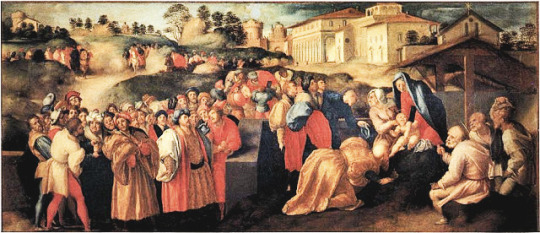
View On WordPress
#Art#Artists#Biography#Fine Art#fineart#footnotes#History#Jacopo Carucci#Jacopo da Pontormo#Jacopo Pontormo#Paintings#Pontormo#Zaidan
0 notes
Text



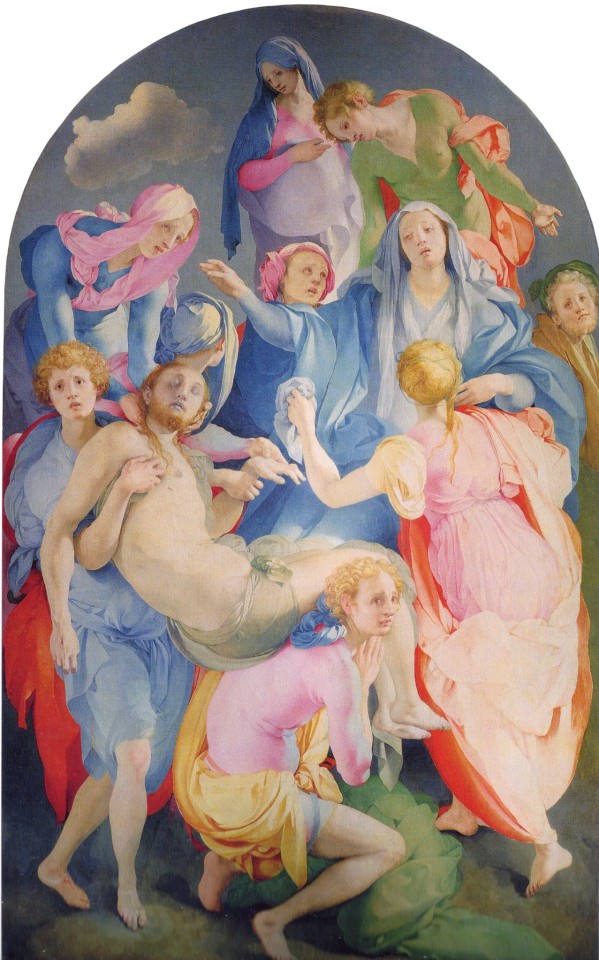
Please reblog for larger sample size
8 notes
·
View notes
Photo
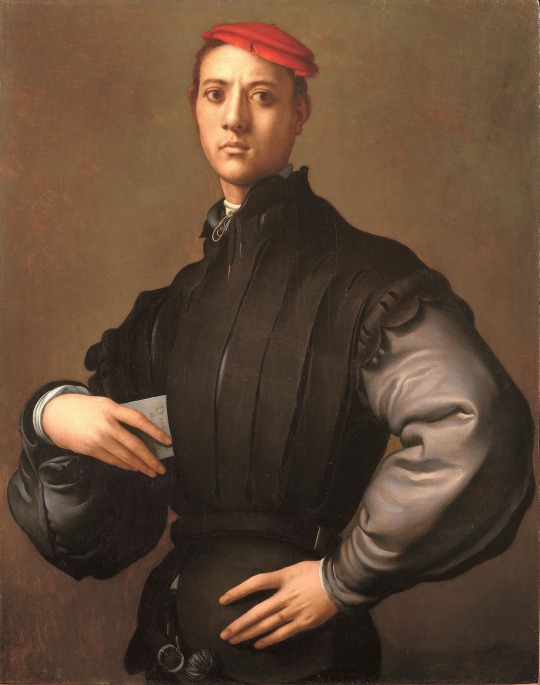
Jacopo Carucci da Pontormo 1494-1557
Portrait of a Young Man in a Red Cap 1529 ca.
Private Collection
25 notes
·
View notes
Text
Andrea del Sarto, pittore
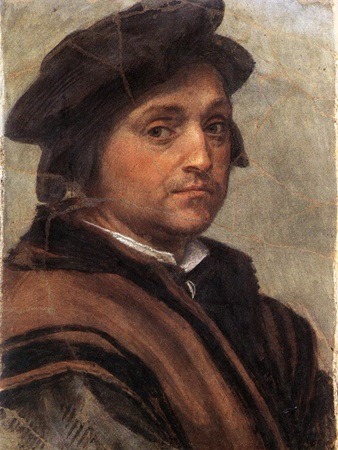
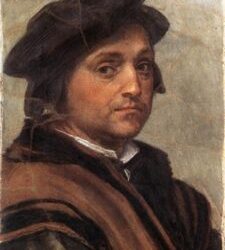
Andrea Vannucci detto del "Sarto" d'Agnolo, meglio conosciuto come Andrea del Sarto mestiere esercitato dal padre. Non c'è sicurezza sul cognome. A volte si trova scritto Vannucci altre con Vannucchi, ma forse il suo cognome è Lanfranchi, come è scritto in un documento riguardante suo fratello. Vi è scitto: Francesco detto "Spillo" Lanfranchi pittore.
Nacque a Firenze nel 1486. Al tempo in cui iniziò il suo periodo di apprendistato come narra nelle "Vite" il Vasari presso una bottega di orafo, presto in quell'ambiente manifestò la sua inclinazione per il disegno. Venne mandato a formarsi nella bottega del pittore Gian Barile. Ma questo dopo poco tempo si accorse di non essere all'altezza delle capacità di Andrea e lo convinse ad andare dal pittore Piero di Cosimo.
All'inizio del XVI° secolo nella nostra città si trovavano artisti del calibro di Leonardo e Michelangelo, ai quali si affiancò superandoli in poco tempo. Fu influenzato dal Perugino, Raffaello, Fra Bartolmeo e Mariotto Albertinelli.
Abitando in Santa Maria Novella fece amicizia con un altro pittore Francesco di Cristofano detto "Franciabigio". I due giovani nel 1516 aprirono una bottega in piazza del Grano, dopo poco tempo si trasferirono vicino alla Basilica della Santissima Annunziata e come tutti i pittori, per poter lavorare dovette iscriversi all'Arte Maggiore dei Medici e Spezali.

I frati Serviti nel 1509 lo incaricarono di affrescare il Chiostrino dei Voti con le storie di San Filippo Benizzi. Iniziò con i frati un rapporto di lavoro distinato a protarsi nel tempo. Ebbe rapporti di committenza con gli Eremitani Agostiniani di San Gallo e i Benedettini Vallombrosani dove già lavorava il "Franciabigio".
Nella loro bottega aprirono la "scuola dell'Annunziata" dove ebbero come discepoli Jacopo Carucci detto "Il Pontormo" e Giovan Battista di Jacopo di Gaspare detto "Il Rosso Fiorentino".
Nel 1515 insieme al "Franciabigio" inizia a dipingere un ciclo decorativo delle Storie del Battista al Chiostro dello "Scalzo" nella chiesa della Compagnia dei Disciplinati di San Giovanni Battista detta dello "Scalzo" (durante le processioni il portatore della croce sfilava a piedi nudi), il lavoro venne terminato nel 1526.

Per la chiesa di San Francesco dei Macci, dipinge la Madonna delle Arpie (oggi conservata agli Uffizi), sposa Lucrezia di Bartolomeo del Fede, divenuta in breve tempo la modella delle sue opere.
Realizza i dipinti per la camera nunziale Borgherini; Le Storie di San Giuseppe; l'Infanzia, Giuseppe interpreta i sogni del Faraone. Per Francesco I° in Francia realizza molte opere quasi tutte andate perdute, rimane solo "la Carità" conservata nel Museo del Louvre. tornato a Firenze riprende a dipingere al Chiostro dello "Scalzo".

Per la villa Medicea di Poggio a Caiano inizia l'affresco "Il Tributo di Cesare", rimasto incompiuto e finito da Alessandro Allori. Dipinge per i Convento di San Salvi "Il Cenacolo" iniziato nel 1519 e terminato dopo dieci anni nel 1529. Su questo bellissimo affresco c'è un aneddoto che racconta: durate l'assedio di Firenze con l'approssimarsi delle truppe dell'Imperatore Carlo V°, venne deciso di abbattere il convento di San Salvi come era stato fatto con San Gallo e San Giusto. Ma i guastatori incaricati della demolizione, si rifiutarono di abbatterlo colpiti dalla bellezza dei suoi colori.
Andrea è ricordato per essere come il più bravo fra i grandi artisti dei suoi tempi. Il Vasari nelle "Vite" lo ricorda cone il "Pittore senza errori", le sue figure erano di somma perfezione, per la capacità di creare composizioni formalmente ineccepibili armoniose e ben bilanciate. Fu un eccellente decoratore di affreschi e autore di bellissime Pale d'Altare e ritratti. Morì di peste causata dall'assedio il 29 settebre 1530, solo e abbandonato dalla moglie.

Alberto Chiarugi
Read the full article
0 notes
Text
Perspective(s)
Laurent Binet nous offre un roman épistolaire doublé d’une enquête policière. Située dans la Florence des Médicis, Perspective(s) est aussi une leçon d’Histoire, une exploration du monde foisonnant de l’art. Érudit, intrigant, emballant!
Lauréat du Prix du Roman historique 2023
En deux mots
Le peintre Jacopo da Pontormo est retrouvé assassiné dans la chapelle San Lorenzo où il achevait la réalisation de fresques. À l’émoi et aux questions suscitées par sa mort vient désormais s’ajouter l’enquête pour retrouver le coupable. Vasari va demander à Michel-Ange de le seconder dans cette tâche dans une Italie où les Médicis sont au cœur…

View On WordPress
#1557#architecte#assassinat#Beaux-arts#broyeur de couleurs#Catherine de Médicis#chapelle Sixtine#Concile de Trente#contre-réforme#correspondance#Cosimo de Médicis#couvent#crime#duc de Florence#Enquête#Famille#Florence#fresques#Médicis#Michel-Ange#peintre#Peinture#reine de France#renaissance tardive#roman épistolaire#Rome#Savonarole#sculpteur#suspect#tableau
0 notes
Text

PONTORMO, Jacopo Carrucci, conocido como el (Pontorme 1494 - Florencia 1556)
Nacimiento de San Juan Bautista (frente)
Escudo de armas de Girolamo Della Casa y Lisetta Tornaquinci (atrás)
hacia 1526-1527
Óleo sobre tabla
Inventario 1890 n. 1532
Esta Natividad del Bautista demuestra afinidades estilísticas con los frescos de Pontormo en la Certosa di Galluzzo, inspirados en la cultura alemana, y con su Cena en Emaús expuesta aquí, también sobre un fondo oscuro. El Nacimiento tiene un carácter arcaico, como lo es el uso del desco da parto: una bandeja creada para llevar la comida a la parturienta, pintada con temas relacionados con la historia sagrada y la continuidad dinástica de la familia. El escudo de armas, colocado entre dos monstruos grotescos, puede hacer referencia al nacimiento de Aldighieri Della Casa, nacido en 1526.
Restauración 1992.
Información de la Gallerie degli Uffizi, imagen/es de mi autoría.
0 notes
Text

Thursday #PortraitChallenge #watercolour and #inkdrawing of ‘Young man tuning a lute’, painted around 1529-1530 in oils on panel by Jacopo Carucci, usually known as Jacopo (da) Pontormo or simply Pontormo
Thank you @StudioTeaBreak
0 notes
Text
78. Entombment of Christ

By Jacopo da Pontormo
Created 1525-1528 CE
Oil on wood
0 notes
Text
Assembly for stompa casa bed notice mode d'emploi
Assembly for stompa casa bed notice mode d'emploi >>Download (Telecharger)
vk.cc/c7jKeU
Assembly for stompa casa bed notice mode d'emploi >> Lire en ligne
bit.do/fSmfG
Name: Assembly for stompa casa bed notice mode d'emploi.pdf
Author: Tervola Porter
Pages: 184
Languages: EN, FR, DE, IT, ES, PT, NL and others
File size: 7276 Kb
Upload Date: 21-10-2022
Last checked: 10 Minutes ago
Notice par Paul Lacroix, notes par Ernest Jnllien. Paris, Ubr. des bibliophiles. In- 16, xvi- 115 p. 7 fr. 50. [160 Tiré à 340 ex. dont 900 sur pap. de Histoire universelle de TEglise catholique par Tabbé Rohrbacher — précédée d'une notice biographique et littéraire par Charles Sainte-Foi augmentée de notes EMPLOI ARBEIT ADMINISTRATION VERWALTUNG Administrateur indépendant, 4 pneus Runflat été neufs, mode eco pro, à disc., Tel Chevrolet Captiva, 11/12, km, 4. JACOPO DA PONTORMO. gradin. Jacopo aida encore Andrea dans une foule d'autres ouvrages. détruisait chaque jour le travail de la veille, et il. La Casa Di Carta Funko Pop Vinile Figura Berlino CHASE 9 cm - Ecco a voi il nuovo Funko POP Berlino. Prodotto ufficiale Funko. Statuetta in vinile n. 743.George Raft .un aveu 4 ayant refusé de s'asseoir avec un client, reçoit des instructions de sa surveillante Elia Nadai.pectivement de 19 et 21 ans, Playmobil Family Fun 9423 - Parco Giochi dei Bambini, dai 4 anni Multicolore - Il grande parco giochi ha una torre di gioco con uno scivolo, un'altalena, una
Assembly for stompa casa bed manuele
Assembly for stompa casa bed manuaalinen
Assembly for stompa casa bed prirucka
Assembly for stompa casa bed service manual
Assembly for stompa casa bed handbook
Assembly for stompa casa bed manualidades
Assembly for stompa casa bed handbog
Assembly for stompa casa bed manually
Assembly for stompa casa bed bedienungsanleitung
Assembly for stompa casa bed owner guide
https://www.tumblr.com/gevavekexof/698810278970867712/for-hozelock-automatic-watering-system-manuel-mode, https://www.tumblr.com/gevavekexof/698810278970867712/for-hozelock-automatic-watering-system-manuel-mode, https://www.tumblr.com/gevavekexof/698809962547363840/handbrake-mercedes-a-class-manuel-mode-demploi, https://www.tumblr.com/gevavekexof/698809792929595392/miele-t8828c-notice-mode-demploi, https://www.tumblr.com/gevavekexof/698810278970867712/for-hozelock-automatic-watering-system-manuel-mode.
0 notes
Photo
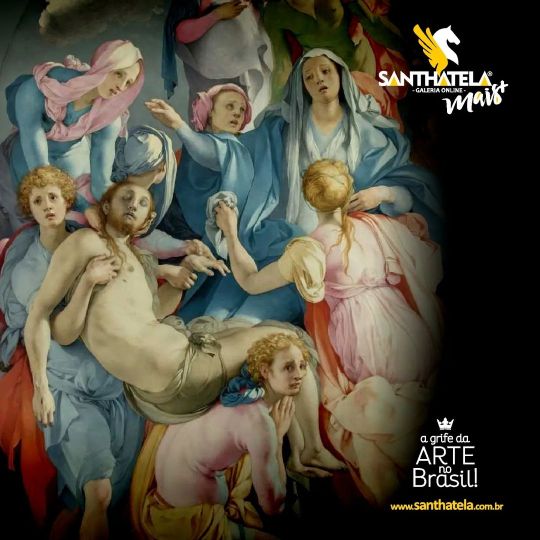
Jacopo Pontormo ▪︎ Santhatela Mais Esta imagem dolorosamente bela do corpo de Cristo sendo levado de sua mãe marca uma cisão radical com o sereno equilíbrio do Alto Renascimento. Embora a pintura seja muitas vezes referida como O Sepultamento, não há um túmulo visível: Pontormo pinta um momento nunca antes representado, quando o corpo de Cristo é tirado de sua mãe, que desfalece com a tristeza. Seu colo vazio é o centro da composição fluida, deliberadamente instável. Eliminando a perspectiva matemática lógica e o modelado sutilmente sombreado dos mestres do Alto Renascimento, Pontormo comprime suas figuras num espaço indefinido, sob uma luz áspera. Poses e distorções elegantemente complexas, luz sinistra e cores sobrenaturais realçam tanto a artificialidade como o efeito inquietantemente emocional da pintura. Segundo Vasari, ele estudou com vários artistas do Alto Renascimento, como Leonardo da Vinci e Andrea del Sarto. Com um talento precoce, logo rompeu com o classicismo de seus mestres para criar um estilo novo e distinto, que parecia refletir sua natureza neurótica. Vasari descreveu-o como um "solitário inimaginável", e seus diários revelam que era ansiosamente obsessivo. Embora seu estilo fosse muito pessoal e original, ele foi influenciado por Michelangelo e pelas gravuras de Albrecht Dürer. Pontormo viveu quase toda a sua carreira em Florença, pintando principalmente obras religiosas e alguns retratos. Embora só nove anos mais velho que seu discípulo Agnolo Bronzino, tornou-se como um pai para ele. Jacopo Carucci, geralmente chamado Jacopo da Pontormo, Jacopo Pontormo ou simplesmente Pontormo nasceu na Itália em 1494. Foi um pintor da renascença no estilo maneirista da Escola Florentina. Foi aprendiz de Andrea del Sarto e de Leonardo Da Vinci juntamente com Rosso Florentino. Era famoso pelo uso de poses contorcidas, perspectiva distorcida, cores marcadamente incomuns e peculiares, que pareciam espelhar seu temperamento neurótico e inquieto. Fonte: História Ilustrada da Arte Obra: Deposição de Cristo Ano: 1526 ▪︎ #cultura #diy #decor #sala #arte #exclusivo #obradearte #decorarte #canvas #decorarparedes #jacopopontormo #conteúdo https://www.instagram.com/p/CfHKWcXLcYl/?igshid=NGJjMDIxMWI=
#cultura#diy#decor#sala#arte#exclusivo#obradearte#decorarte#canvas#decorarparedes#jacopopontormo#conteúdo
1 note
·
View note
Text
Art History Reader: Mannerism

Parmigianino, Self-Portrait in a Convex Mirror, ca. 1523-1524. Source.
Something very strange was going on in Italy around the turn of the 16th century. The country was just cresting the wave of one of the most dazzling periods in Western art–the Italian High Renaissance–and yet suddenly, things were starting to look a little… off. The rationality and harmonious proportions of the High Renaissance gave way to outrageous anatomies, weird poses, wild colors, and mysterious meanings. Common sense was thrown out the window, and everything grew illogical, distorted, and just plain weird. Why did Renaissance art start doing this?
The style that emerged in the 1520s and lasted until 1600 (a period sometimes called the Late Renaissance) came to be known as Mannerism. It is named after “maniera”, an Italian term for “style” or “manner,” and refers to a stylized, exaggerated approach to painting and sculpture. When the term was first widely used in the 17th century, it was used pejoratively to disparage the Italian Renaissance art from this period, which later audiences deemed overly stylized and tasteless, a far cry from the classicism of the High Renaissance greats like Raphael and Michelangelo (although, if one were to look very closely at the Sistine Chapel ceiling, they would see the earliest stirrings of mannerist tendencies in Michelangelo’s figures). Today, however, Mannerism isn’t such a loaded term–we have 20th century expressionism and abstraction to thank for our modern weirdness metric–and instead we use it to broadly refer to 16th century art throughout Europe (and even in places like the Americas after Europeans arrived) that is fantastically stylized, highly artificial, somewhat distorted, and often emotionally provocative.
Perhaps because of its place as the “bridge” between the rationality of the Renaissance and the magnificence of the Baroque, Mannerism has always been a tough “-ism” to grasp. Its defining characteristics don’t seem to define anything at all. So in an effort to make sense of this odd moment in art, let’s try to nail down three solid characteristics:
Exaggeration
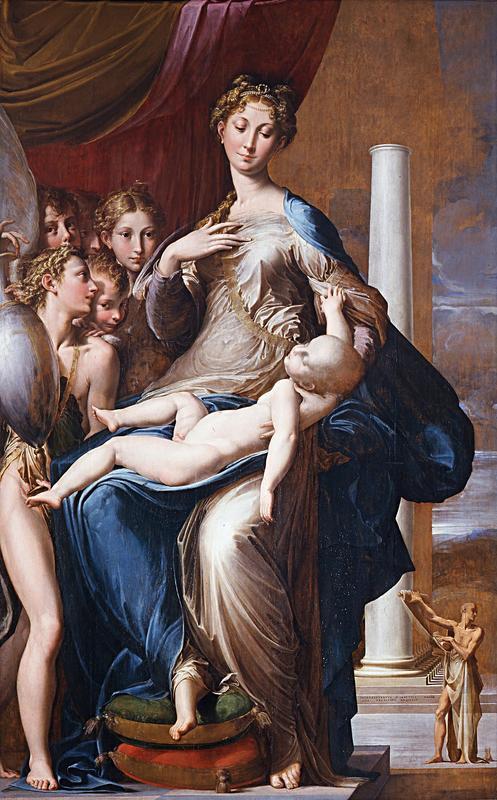
Parmigianino, Madonna with the Long Neck, 1535-1540. Source.
Long. Necks.
Or at least that was Italian artist Parmigianino’s approach when he painted Madonna with the Long Neck, sometimes called Madonna and Long Child with Angels and St. Jerome–either way, the subject matter’s general long-ness is emphasized. In the painting, we see the central figure of the Virgin dominate the composition, her long body coming to a point at her tiny head tilted upon an impossibly long neck. The Christ child lays sprawled across her lap, unnaturally long as well, while a group of clustered angels admire him from a narrow space on the right side of the painting. The left side of the painting is largely empty except for a sparse column in the background and the tiny figure of the prophet, Saint Jerome, who holds open a scroll, presumably full of mysterious prophecies. The background recedes dramatically into deep, deep space that seemingly goes on for miles. This is a work of extreme exaggeration. Everything, from the proportions of the figures to the illogical perspective to the random architectural elements, serves to pull you into the otherworldly space of the divine, where correct proportions are not required.
Artificial Color

Jacopo da Pontormo, The Deposition, ca. 1525-1528. Source.
Many Mannerist artists shunned the naturalistic colors used by the High Renaissance artists in favor of more unrealistic hues. The Italian artist Jacopo da Pontormo was especially fond of painting with a highly saturated palette, which we can see on full display in The Deposition. The scene is a chaotic mass of twisting bodies that all appear washed out, as if they were photographed using the brightest flash setting on a camera. The colors become even stranger the longer you examine the figures and begin to notice that some of them appear to sport pink and blue torsos, colors extending from–yet indistinguishable from–their clothing. The garish colors nearly distract you from the subject matter: Christ in the moment that he is taken down from the cross. It seems unusual that Pontormo would use such a garish palette to depict this poignant scene of grief and suffering, but then again, Mannerism is nothing if not unusual.
Elaborate Ornamentation

Giuseppe Arcimboldo, Vertumnus, 1591. Source.
Speaking of unusual, one Mannerist artist was in a league of his own entirely. Giuseppe Arcimboldo was the court painter to the eccentric Holy Roman Emperor Rudolf II at his palace in Prague. The emperor was a great patron and collector of art (in fact, he patronized so much Mannerist art that the adjective Rudolfine, as in “Rudolfine Mannerism,” is often used in art history to describe the work created in Prague during his reign as emperor), and in the service of his court, Arcimboldo had found his audience. The emperor had a penchant for exotic animals, botanical gardens, and any strange object he could house in his extensive “cabinet of curiosities.” Arcimboldo’s imaginative portrait heads, made entirely of objects such as fruits, vegetables, flowers, fish and books fit right in. His whimsical works were certainly made to entertain the court, but more than just odd, fanciful pictures, these works reflect a part of Renaissance culture that isn’t often discussed.
The Renaissance was not just a period of interest in–and revival of–ideas from antiquity, it was also a period of great curiosity, discovery, and anxiety. The early and mid-16th century was a period of enormous social, economic, and political change throughout the world. The rise of capitalism and absolutism, colonization and exploitation of new lands and peoples, and new developments in the science of anatomy and optics contributed to a general sense of unease and ambiguity, which some could argue is reflected in Mannerism’s contorted and unbalanced forms.
The 16th century also saw the rise of a wealthy merchant class, thanks in large part to the forced colonization of distant lands, and they wanted to spend that money on art. The tastes of aristocratic patrons, particularly those within court circles, directly influenced the self-conscious artifice and deliberate complexity of Mannerist art. Patrons were eager to own a piece of art on the cutting edge of the new developments in style so they could show off their knowledge and good taste.
Lastly, perhaps the most direct influence on Mannerist art was the rise of the status of the artist from the nameless craftsmen in a Medieval guild to the single-named celebrities we think of today: Michelangelo, Botticelli, Tintoretto, and so on. The elevation of individual potential–a facet of humanist thought–inevitably led to the development of personal style. Collecting the art of someone with their own distinctive style meant you were also collecting their ingenuity and intellect. Stylishness was therefore a must by the mid-16th century.
Eventually, the Catholic Counter-Reformation would declare Mannerist art too sensuous and ambiguous for depicting religious imagery. In 1563, the Council of Trent–the governing body in charge of reforming the Catholic church–met for a final session to discuss images specifically. While the council was not specific about what art should look like, it did express that sacred images should be clear and devoid of showy artistry. Put another way, art should not be lascivious or frivolous, it should not perplex viewers (which Mannerists seemingly loved to do), and ultimately, it should serve an educational purpose, moving viewers to further dedicate their lives to Christ. This all came at a time when the Church was anxious to counter Protestant idolatry, which called for the destruction of all religious images, claiming they encouraged the worship of false idols. After all, the majority of people at the time were illiterate, so the educational role of images for teaching the Catholic faithful could not be understated. This role became especially crucial as the Church expanded its reach with conquests, colonialism, and evangelization beyond Europe during the 16th century.
The effects of the Counter-Reformation on art would be felt for decades, and the Mannerists were effectively stymied by the anxiety of images felt throughout Catholic Christendom. This is not to say that Mannerism didn’t find a way to adapt to the Tridentine (adj. meaning, relating to the Council of Trent) decrees. One notable example was the Spanish master, El Greco (born Domenikos Theotokopoulos), or The Greek. Born and raised in Crete, El Greco was trained as a Greek icon painter (in a post-Byzantine style). He left for Venice at age twenty-six, where he worked in Titian’s workshop and was influenced by Tintoretto’s loose brushwork. He then traveled to Rome before settling in Toledo, Spain in 1577 to work for the Spanish King Philip II. He lived there until his death in 1614.
Toledo was a very Catholic place, so you can imagine El Greco–in the service of the King, no less–would have been eager to stick to the Tridentine edicts on images. And for the most part, he was! His painting, Burial of the Count of Orgaz (1586–88), with its depiction of saints in both the earthly and heavenly realms, strongly reaffirmed the importance of saints as the intercessors between humans and the divine (and provided a major counter to the Protestant attacks on saints in the Church). El Greco’s ability to pair the mystical and the spiritual with the life around him was just what Counter Reformation art was looking for. However, one needs only to observe his elongated, strangely lit figures, use of unnatural color, and odd fisheye lens perspective to see that Mannerist techniques are alive and well in his work.
Despite attacks from the most intimidating governing body in the world at the time, Mannerism went on to have a lasting legacy. Many years after the decline of the Mannerists, Baroque artists dared to create dynamic and dramatic works showcasing a refinement of the experimentation their predecessors pioneered. Mannerism paved the way and emboldened future generations of artists to innovate and push the boundaries of style. More than just a weird little moment sandwiched between the well-known Renaissance and Baroque periods, Mannerism indicated the moment that art became individualized, self-consciously stylized, and elevated as a tool with which the elite could compare intellectual notes. In other words, Mannerism was a radically modern moment in art, a fantastically weird period of discovery that resulted in an explosion of creativity that still intrigues audiences almost 500 years later.
Key Works of Art:
Madonna with the Long Neck by Parmigianino
The Last Judgment by Michelangelo
Salt Cellar by Benvenuto Cellini
Perseus with the Head of Medusa by Benvenuto Cellini
The Deposition by Jacopo da Pontormo
Venus, Cupid, Folly and Time by Bronzino
Martyrdom of St. Lawrence by Bronzino
Eleanora di Toledo with Her Son Giovanni de' Medici by Bronzino
Last Supper by Tintoretto
Autumn by Giuseppe Arcimboldo
Vertumnus by Giuseppe Arcimboldo
The Librarian by Giuseppe Arcimboldo
Six Tuscan Poets by Giorgio Vasari
The Burial of the Count of Orgaz by El Greco
Opening of the Fifth Seal by El Greco
St. John the Baptist by El Greco
Related Movements:
The Renaissance
Humanism
Baroque
By: Jennifer L. Gutierrez
1 note
·
View note
Text

Jacopo da Pontormo, Vertumnus and Pomona, c1520
(2005)
50 notes
·
View notes
Photo
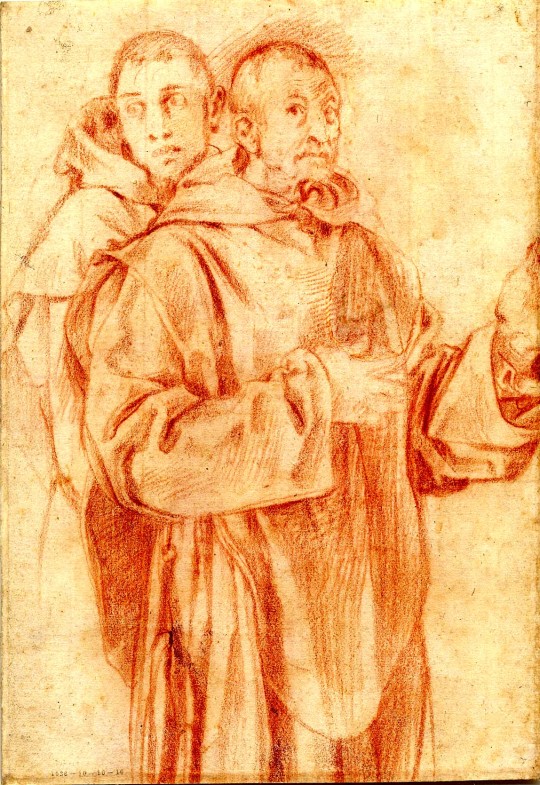
Jacopo Carrucci da Pontormo 1494-1557
Study of two monks, one standing behind the other 1522-1525
British Museum
11 notes
·
View notes